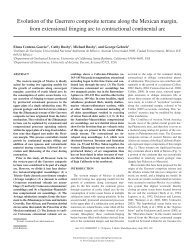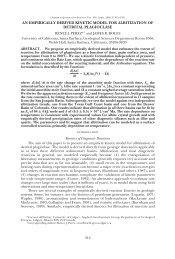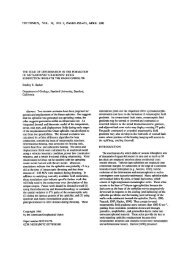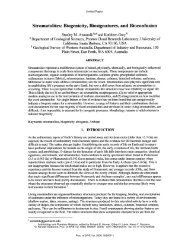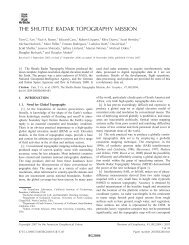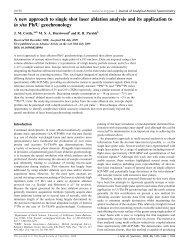Campaign-style titanite U-Pb dating by ICP - Earth Science ...
Campaign-style titanite U-Pb dating by ICP - Earth Science ...
Campaign-style titanite U-Pb dating by ICP - Earth Science ...
You also want an ePaper? Increase the reach of your titles
YUMPU automatically turns print PDFs into web optimized ePapers that Google loves.
650651652653654655656657658659660661662663664665666667668669670671672The in-run uncertainty of isotopic ratios measured in secondary RMs and unknownsis, naturally, greater. Analysis of secondary RMs with homogeneous isotopic ratios (e.g.,zircon) demonstrates that the uncertainty of individual 206 <strong>Pb</strong>/ 238 U measurements isdominated <strong>by</strong> counting statistics and signal stability; a typical uncertainty can berepresented <strong>by</strong> the Tukey’s biweight mean of ~1.9% calculated for the >3400 unknownsreported here. In contrast, individual 207 <strong>Pb</strong>/ 206 <strong>Pb</strong> measurements are much moreprecise—Tukey’s biweight mean is 0.2%—and require an additional 2% external errorattributable either to variation in ablation or transport characteristics; this was added inquadrature.The 238 U/ 206 <strong>Pb</strong> and 207 <strong>Pb</strong>/ 206 <strong>Pb</strong> isotopic ratios for each analysis were plotted on Tera–Wasserburg (1972) diagrams using Isoplot [Ludwig, 2003]. Because LA-<strong>ICP</strong>-MS allowsone to collect many analyses from the same <strong>titanite</strong> or the same sample, the analysesoften have sufficient spread in U/<strong>Pb</strong> ratios to define a 238 U/ 206 <strong>Pb</strong>– 207 <strong>Pb</strong>/ 206 <strong>Pb</strong> isochronwithout the need to assume a common 207 <strong>Pb</strong>/ 206 <strong>Pb</strong> ratio from a model [e.g., Stacey andKramers, 1975] model or from a low-U mineral presumed to be in equilibrium. All of the<strong>ICP</strong> dates reported here are thus 238 U/ 206 <strong>Pb</strong>– 207 <strong>Pb</strong>/ 206 <strong>Pb</strong> isochrons. All dateuncertainties are reported at the 95% confidence interval, assuming a Gaussiandistribution of measurement errors.For samples with a broad spread of U-<strong>Pb</strong> ratios—and thus, a well-constrained common 207 <strong>Pb</strong>/ 206 <strong>Pb</strong> ratio—we report the 238 U/ 206 <strong>Pb</strong>–207 <strong>Pb</strong>/ 206 <strong>Pb</strong> isochron date. For samples with a small spread of U-<strong>Pb</strong> ratios—and thus, apoorly constrained common 207 <strong>Pb</strong>/ 206 <strong>Pb</strong> ratio—we anchor the ratio to the Stacey–Kramers [1975] value of 0.912 ± 0.05, appropriate for differentiation ages of 1660–400Ma.37



